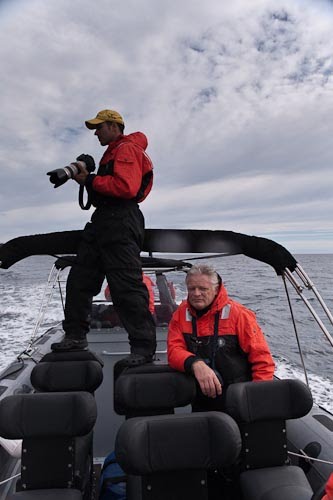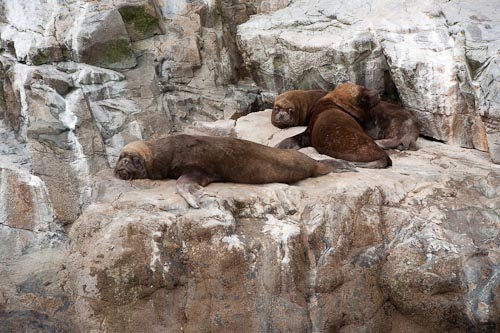
We get in close to Dolphins and Sealions but the Whales stay away
The Gulf of Corcovado is a wide stretch of Pacific between mainland Chile and Chiloe one of the county’s largest offshore islands and one made famous by the fifteen different species of exotic potatoes it exports around the world. This Gulf is the acknowledged breeding ground of many whale types including Hump Back, Killer, Sperm, and the Blue Pigmy, which despite its diminutive name is hardly small with the word pigmy describing the animal’s dorsal fin.
The area is also home to White Shark, Sea Lion and the Peals Dolphin a white-bellied smaller cousin of the Bottlenose and is endemic to this part of the South American coast. Normally an ocean dwelling fish preferring the deeper off shore waters, this part of Chile seems to attract the Peals close inshore.
Atmosphere carries a huge adventure RIB built by Zodiac packing twin 250hp Yamaha outboards and equipped with shock absorbing seats and a enough navigation equipment to rival the average super yacht. This ocean going craft is our chosen means of transport to explore the Gulf and chance a brief encounter with the whales.
We left the security of our mother ship and were, within minutes, surrounded by a pod of Peals dolphin who wanted to play. Maintaining a speed of around seven knots this playful creatures swooped in and out of our bow wave leaping into the air and smacking down onto the water with a loud crack as it to say “come on then lets see you do that!” When they bore of us they slope off to feed somewhere and we put on the power and head for a point mid channel some 10 miles off the shore. With
Pablo at the helm and the throttles pushed well forward, this did not take long at speeds of over 40 knots. We cut the engines and deployed the RIB’s on board hydrophones and set back to wait the arrival of the massive marine mammals, while at the same time, keeping our yes well peeled for the spouting of water or the breaching of a tail fin.

Sadly today was not going to be the day we see whales and after futilely wallowing in the Pacific swell for an hour or so we decide to move on in search of other animals. We are not disappointed.
The rare red footed cormorant is shopping for fish in great numbers and we see the caves in which they live. The Chilean Navy has blown many of these caves up on this coast to prevent smuggling and the illegal growing of molluscs and this has had a dramatic adverse effect on the number of these birds that survive in the wild. The more common rock cormorant is not quite so fussy and we see them in great numbers as well.
High above the rocks red headed turkey vultures swoop and dive and are a clear indicator that sea lion are close by and sure enough as we close the shore we see colonies of them basking in the sun. Huge fat males growl at each other protecting their territory and slim-line mother versions look after the young nearby.
We are careful not to spook them. In the past it has been noticed that in their haste to get into the water and become instantly more agile, the large males have lumbered over the innocent babies squashing them flat. They get into the water for us in an organised fashion and duck and weave in the pacific swell and their antic more than make up for the fact that we have failed to find the whales.
Atmosphere is available for charter through Robert Shepherd at Edmiston
